中国八大菜系英文介绍20995
- 格式:doc
- 大小:534.50 KB
- 文档页数:8
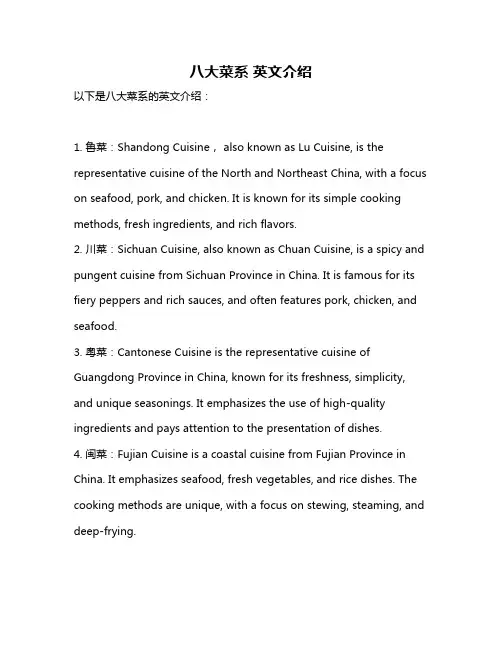
八大菜系英文介绍以下是八大菜系的英文介绍:1. 鲁菜:Shandong Cuisine, also known as Lu Cuisine, is the representative cuisine of the North and Northeast China, with a focus on seafood, pork, and chicken. It is known for its simple cooking methods, fresh ingredients, and rich flavors.2. 川菜:Sichuan Cuisine, also known as Chuan Cuisine, is a spicy and pungent cuisine from Sichuan Province in China. It is famous for its fiery peppers and rich sauces, and often features pork, chicken, and seafood.3. 粤菜:Cantonese Cuisine is the representative cuisine of Guangdong Province in China, known for its freshness, simplicity, and unique seasonings. It emphasizes the use of high-quality ingredients and pays attention to the presentation of dishes.4. 闽菜:Fujian Cuisine is a coastal cuisine from Fujian Province in China. It emphasizes seafood, fresh vegetables, and rice dishes. The cooking methods are unique, with a focus on stewing, steaming, and deep-frying.5. 苏菜:Jiangsu Cuisine is a representative cuisine of the Yangtze River Delta region in China. It emphasizes freshness, tenderness, and mild flavors. The cooking methods are diverse, including stewing, steaming, frying, and braising.6. 浙菜:Zhejiang Cuisine is a representative cuisine of the eastern region of China, known for its simplicity and unique flavors. It often features rice dishes, seafood, and various kinds of meat. The cooking methods include stewing, steaming, and frying.7. 湘菜:Xiang Cuisine is a spicy and pungent cuisine from Hunan Province in China. It emphasizes the use of fresh ingredients and fiery peppers, often featuring pork, chicken, and beef. The cooking methods include stewing, steaming, and deep-frying.8. 徽菜:Anhui Cuisine is a traditional Chinese cuisine from Anhui Province, known for its unique flavors and seasonings. The main ingredients include pork, chicken, duck, and various kinds of vegetables. The cooking methods include stewing, steaming, frying, and braising.。
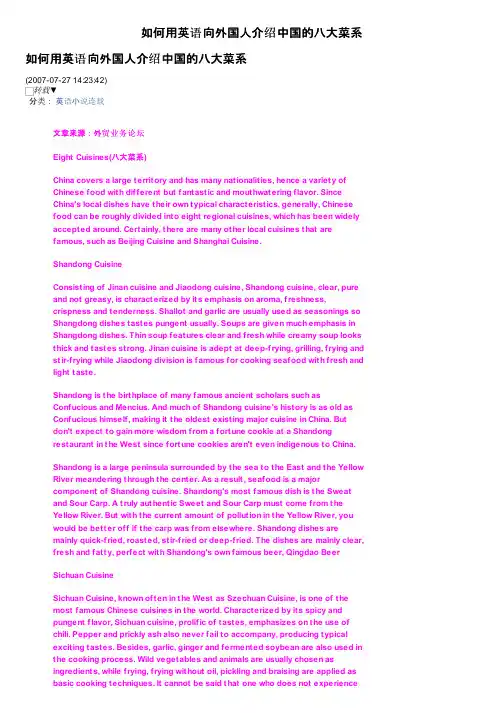
如何用英语向外国人介绍中国的八大菜系如何用英语向外国人介绍中国的八大菜系(2007-07-27 14:23:42)转载▼分类:英语小说连载文章来源:外贸业务论坛Eight Cuisines(八大菜系)China covers a large territory and has many nationalities, hence a variety ofChinese food with different but fantastic and mouthwatering flavor. SinceChina's local dishes have their own typical characteristics, generally, Chinesefood can be roughly divided into eight regional cuisines, which has been widely accepted around. Certainly, there are many other local cuisines that arefamous, such as Beijing Cuisine and Shanghai Cuisine.Shandong CuisineConsisting of Jinan cuisine and Jiaodong cuisine, Shandong cuisine, clear, pure and not greasy, is characterized by its emphasis on aroma, freshness,crispness and tenderness. Shallot and garlic are usually used as seasonings so Shangdong dishes tastes pungent usually. Soups are given much emphasis inShangdong dishes. Thin soup features clear and fresh while creamy soup looks thick and tastes strong. Jinan cuisine is adept at deep-frying, grilling, frying and stir-frying while Jiaodong division is famous for cooking seafood with fresh and light taste.Shandong is the birthplace of many famous ancient scholars such asConfucious and Mencius. And much of Shandong cuisine's history is as old asConfucious himself, making it the oldest existing major cuisine in China. Butdon't expect to gain more wisdom from a fortune cookie at a Shandongrestaurant in the West since fortune cookies aren't even indigenous to China.Shandong is a large peninsula surrounded by the sea to the East and the Yellow River meandering through the center. As a result, seafood is a majorcomponent of Shandong cuisine. Shandong's most famous dish is the Sweatand Sour Carp. A truly authentic Sweet and Sour Carp must come from theYellow River. But with the current amount of pollution in the Yellow River, youwould be better off if the carp was from elsewhere. Shandong dishes aremainly quick-fried, roasted, stir-fried or deep-fried. The dishes are mainly clear, fresh and fatty, perfect with Shandong's own famous beer, Qingdao BeerSichuan CuisineSichuan Cuisine, known often in the West as Szechuan Cuisine, is one of themost famous Chinese cuisines in the world. Characterized by its spicy andpungent flavor, Sichuan cuisine, prolific of tastes, emphasizes on the use ofchili. Pepper and prickly ash also never fail to accompany, producing typicalexciting tastes. Besides, garlic, ginger and fermented soybean are also used in the cooking process. Wild vegetables and animals are usually chosen asingredients, while frying, frying without oil, pickling and braising are applied asbasic cooking techniques. It cannot be said that one who does not experienceSichuan food ever reaches China.If you eat Sichuan cuisine and find it too bland, then you are probably not eating authentic Sichuan cuisine. Chili peppers and prickly ash are used in many dishes, giving it a distinctively spicy taste, called ma in Chinese. It often leaves a slight numb sensation in the mouth. However, most peppers were brought to China from the Americas in the 18th century so you can thank global trade for much of Sichuan cuisine's excellence. Sichuan hot pots are perhaps the most famous hotpots in the world, most notably the Yuan Yang (mandarin duck) Hotpot half spicy and half clear.Guangdong CuisineCantonese food originates from Guangdong, the southernmost province in China. The majority of overseas Chinese people are from Guangdong (Canton) so Cantonese is perhaps the most widely available Chinese regional cuisine outside of China.Cantonese are known to have an adventurous palate, able to eat manydifferent kinds of meats and vegetables. In fact, people in Northern Chinaoften say that Cantonese people will eat anything that flies except airplanes, anything that moves on the ground except trains, and anything that moves in the water except boats. This statement is far from the truth, but Cantonese food is easily one of the most diverse and richest cuisines in China. Many vegetables originate from other parts of the world. It doesn't use much spice, bringing out the natural flavor of the vegetables and meats.Tasting clear, light, crisp and fresh, Guangdong cuisine, familiar to Westerners, usually chooses raptors and beasts to produce originative dishes. Its basic cooking techniques include roasting, stir-frying, sauteing, deep-frying, braising, stewing and steaming. Among them steaming and stir-frying are more commonly applied to preserve the natural flavor. Guangdong chefs also pay much attention to the artistic presentation of dishes.Fujian CuisineConsisting of Fuzhou Cuisine, Quanzhou Cuisine and Xiamen Cuisine, Fujian Cuisine is distinguished for its choice seafood, beautiful color and magic taste of sweet, sour, salty and savory. The most distinct features are their "pickled taste".Jiangsu CuisineJiangsu Cuisine, also called Huaiyang Cuisine, is popular in the lower reach of the Yangtze River. Aquatics as the main ingredients, it stresses the freshness of materials. Its carving techniques are delicate, of which the melon carving technique is especially well known. Cooking techniques consist of stewing, braising, roasting, simmering, etc. The flavor of Huaiyang Cuisine is light, fresh and sweet and with delicate elegance. Jiangsu cuisine is well known for its careful selection of ingredients, its meticulous preparation methodology, and its not-too-spicy, not-too-bland taste. Since the seasons vary in climate considerably in Jiangsu, the cuisine also varies throughout the year. If the flavor is strong, it isn't too heavy; if light, not too bland.Zhejiang CuisineComprising local cuisines of Hangzhou, Ningbo and Shaoxing, Zhejiang Cuisine, not greasy, wins its reputation for freshness, tenderness, softness, smoothness of its dishes with mellow fragrance. Hangzhou Cuisine is the most famous one among the three.Hunan cuisineHunan cuisine consists of local Cuisines of Xiangjiang Region, Dongting Lake and Xiangxi coteau. It characterizes itself by thick and pungent flavor. Chili, pepper and shallot are usually necessaries in this division.Anhui CuisineAnhui Cuisine chefs focus much more attention on the temperature in cooking and are good at braising and stewing. Often hams will be added to improve taste and sugar candy added to gain。
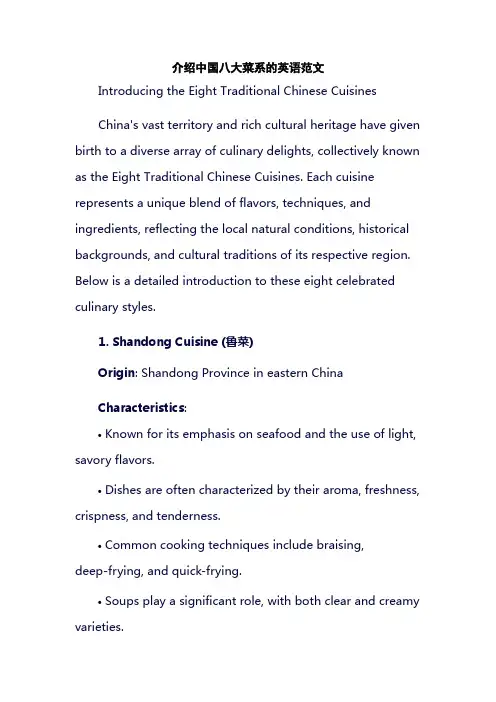
介绍中国八大菜系的英语范文Introducing the Eight Traditional Chinese CuisinesChina's vast territory and rich cultural heritage have given birth to a diverse array of culinary delights, collectively known as the Eight Traditional Chinese Cuisines. Each cuisine represents a unique blend of flavors, techniques, and ingredients, reflecting the local natural conditions, historical backgrounds, and cultural traditions of its respective region. Below is a detailed introduction to these eight celebrated culinary styles.1. Shandong Cuisine (鲁菜)Origin: Shandong Province in eastern ChinaCharacteristics:•Known for its emphasis on seafood and the use of light, savory flavors.•Dishes are often characterized by their aroma, freshness, crispness, and tenderness.•Common cooking techniques include braising,deep-frying, and quick-frying.•Soups play a significant role, with both clear and creamy varieties.Popular Dishes: Sweet and sour carp, braised abalone, fried sea cucumber, and sea cucumber braised with scallion.2. Sichuan Cuisine (川菜)Origin: Sichuan Province in southwestern ChinaCharacteristics:•Famous for its bold and spicy flavors, often accompanied by a numbing sensation.•Heavily relies on the use of chili peppers, garlic, and Sichuan peppercorns.•Dishes exhibit a wide range of tastes and textures.Popular Dishes: Mapo tofu, kung pao chicken, hot pot, and spicy boiled fish.3. Cantonese Cuisine (粤菜)Origin: Guangdong Province in southern ChinaCharacteristics:•Known for its delicate and fresh flavors, with a strong emphasis on seafood.•Techniques such as stir-frying and steaming are widely used.•Minimal use of spices allows the natural flavors of ingredients to shine.Popular Dishes: Dim sum, sweet and sour pork, wonton soup, and honey-glazed barbecued pork.4. Jiangsu Cuisine (苏菜)Origin: Jiangsu Province in eastern ChinaCharacteristics:•Renowned for its delicate and light flavors, emphasizing the freshness and seasonality of ingredients.•Dishes are meticulously prepared and presented.•Aquatic products are a staple, and cooking techniques include stewing, braising, and roasting.Popular Dishes: Squirrel-shaped mandarinfish, lion's head meatballs, and salted duck.5. Zhejiang Cuisine (浙菜)Origin: Zhejiang Province in eastern ChinaCharacteristics:•Known for its fresh and tender flavors, with a focus on seafood and bamboo shoots.•Techniques such as steaming, braising, and stewing are prevalent.•Dishes often showcase the natural sweetness and tenderness of ingredients.Popular Dishes: Dongpo pork, West Lake vinegar fish, and beggar's chicken.6. Hunan Cuisine (湘菜)Origin: Hunan Province in central ChinaCharacteristics:•Similar to Sichuan cuisine in its bold and spicy flavors but less numbing and more aromatic.•Heavily features chili peppers, garlic, and other spices.•Dishes often have a complex and layered taste profile.Popular Dishes: Chairman Mao's red-braised pork, steamed fish head with chopped chili, and stir-fried pork with smoked tofu.7. Fujian Cuisine (闽菜)Origin: Fujian Province in southeastern ChinaCharacteristics:•Known for its emphasis on seafood and umami-rich flavors.•Uses a wide variety of ingredients, including seafood, mushrooms, and bamboo shoots.•Techniques such as braising and stewing are common.Popular Dishes: Buddha Jumps Over the Wall, oyster omelette, and fish ball soup.8. Anhui Cuisine (徽菜)Origin: Anhui Province in eastern ChinaCharacteristics:•Known for its use of wild herbs and game meats, as well as its braising, stewing, and slow-cooking techniques.•Dishes emphasize the natural flavors of the ingredients and often have a salty and umami taste profile.Popular Dishes: Braised turtle with ham, salt-baked chicken, and bamboo shoots with pork belly.In summary, the Eight Traditional Chinese Cuisines offer a rich tapestry of flavors, techniques, and ingredients that reflect the diversity and depth of China's culinary heritage. Each cuisine is a testament to the ingenuity and creativity of itschefs, who have honed their skills over generations to create dishes that are both delicious and deeply rooted in their respective cultural traditions.。
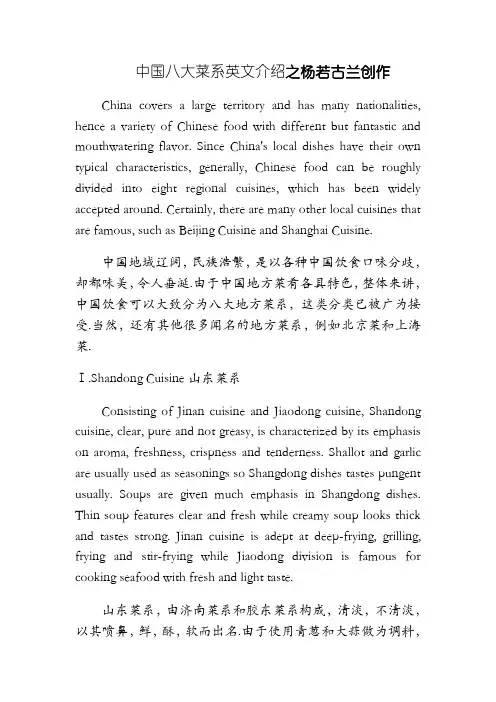
中国八大菜系英文介绍之杨若古兰创作China covers a large territory and has many nationalities, hence a variety of Chinese food with different but fantastic and mouthwatering flavor. Since China's local dishes have their own typical characteristics, generally, Chinese food can be roughly divided into eight regional cuisines, which has been widely accepted around. Certainly, there are many other local cuisines that are famous, such as Beijing Cuisine and Shanghai Cuisine.中国地域辽阔,民族浩繁,是以各种中国饮食口味分歧,却都味美,令人垂涎.由于中国地方菜肴各具特色,整体来讲,中国饮食可以大致分为八大地方菜系,这类分类已被广为接受.当然,还有其他很多闻名的地方菜系,例如北京菜和上海菜.Ⅰ.Shandong Cuisine山东菜系Consisting of Jinan cuisine and Jiaodong cuisine, Shandong cuisine, clear, pure and not greasy, is characterized by its emphasis on aroma, freshness, crispness and tenderness. Shallot and garlic are usually used as seasonings so Shangdong dishes tastes pungent usually. Soups are given much emphasis in Shangdong dishes. Thin soup features clear and fresh while creamy soup looks thick and tastes strong. Jinan cuisine is adept at deep-frying, grilling, frying and stir-frying while Jiaodong division is famous for cooking seafood with fresh and light taste.山东菜系,由济南菜系和胶东菜系构成,清淡,不清淡,以其喷鼻,鲜,酥,软而出名.由于使用青葱和大蒜做为调料,山东菜系通常很辣.山东菜系重视汤品.清汤清澈新颖,而油汤外观厚重,滋味浓重.济南菜系擅长炸,烤,煎,炒,而胶东菜系则以其烹饪海鲜的鲜淡而出名.Shandong is the birthplace of many famous ancient scholars such as Confucious and Mencius. And much of Shandong cuisine's history is as old as Confucious himself, making it the oldest existing major cuisine in China. But don't expect to gain more wisdom from a fortune cookie at a Shandong restaurant in the West since fortune cookies aren't even indigenous to China.山东是很多闻名学者的故乡,例如孔夫子和孟子.很多山东菜的历史和孔夫子一样悠长,使得山东菜系成为中国现存的最古老的次要菜系之一.但是不要期望在东方国家的山东菜馆里从签饼(中国餐馆的折叠形小饼,内藏有猜测命运话语的纸条)获得更多的好命运,由于签饼在中国也不是本土的.Shandong is a large peninsula surrounded by the sea to the East and the Yellow River meandering through the center. As a result, seafood is a major component of Shandong cuisine. Shandong's most famous dish is the Sweat and Sour Carp. A truly authentic Sweet and Sour Carp must come from the Yellow River. But with the current amount of pollution in the Yellow River, you would be better off if the carp was from elsewhere. Shandong dishes are mainly quick-fried, roasted, stir-fried or deep-fried. The dishes are mainly clear, fresh and fatty, perfect with Shandong's own famous beer, Qingdao Beer山东是个巨大的被向东流去的大海环绕的半岛,黄河曲折的流经其中部.是以海鲜是山东菜系的次要构成.山东最闻名的菜肴是糖醋鲤鱼.正宗的糖醋鲤鱼必须打捞自黄河.但是由于此刻黄河的浩繁净化,其他地方的鲤鱼更好一些.山东菜主如果速炸,烧烤,炒或深炸.菜肴清新肥美,搭配山东当地的闻名啤酒——青岛啤酒就完满了.德州扒鸡Dezhou Braised Chicken四喜丸子 Sixi Balls糖醋鲤鱼Carp in Sweet and Sour Sauce辣子全鸡Spicy chicken whole爆炒腰花 Quickly Fried Pig Kidney(saute kidney)清汤柳叶燕菜Stewed Swiflets Nest一品豆腐“Yiping”Bean Curd五花肉烧冻豆腐Braised Frozen Bean Curd with Streaky Pork炸蚕蛹鸡Fried “Silkworm Pupa” Chicken红烧鱼唇Fried Fish Lip in Brown Sauce坛子肉 Braised Pork in Crock酱爆肉丁Saute Pork with Soy Bean Sauce冬菇烧蹄筋Braised Pork Tendon with MushroomⅡ.Sichuan Cuisine四川菜系Sichuan Cuisine, known often in the West as Szechuan Cuisine, is one of the most famous Chinese cuisines in the world.Characterized by its spicy and pungent flavor, Sichuan cuisine, prolific of tastes, emphasizes on the use of chili. Pepper and prickly ash also never fail to accompany, producing typical exciting tastes. Besides, garlic, ginger and fermented soybean are also used in the cooking process. Wild vegetables and animals are usually chosen as ingredients, while frying, frying without oil, pickling and braising are applied as basic cooking techniques.四川菜系,是世界上最闻名的中国菜系之一.四川菜系以其喷鼻辣而出名,滋味多变,侧重使用红辣椒,搭配使用青椒和prickly ash,发生出经典的刺激的滋味.此外,大蒜,姜和豆豉也被利用于烹饪过程中.野菜和野禽常被选用为原料,油炸,无油炸,腌制和文火炖煮是基本的烹饪技术. If you eat Sichuan cuisine and find it too bland, then you are probably not eating authentic Sichuan cuisine. Chili peppers and prickly ash are used in many dishes, giving it a distinctively spicy taste, called ma in Chinese. It often leaves a slight numb sensation in the mouth. However, most peppers were brought to China from the Americas in the 18th century so you can thank global trade for much of Sichuan cuisine's excellence. Sichuan hot pots are perhaps the most famous hotpots in the world, most notably the Yuan Yang (mandarin duck)Hotpot half spicy and half clear.如果你吃四川菜,发现它过于柔和,那么你可能吃的不是正宗的四川菜.红绿辣椒被用在很多菜肴中,带来特此外辣味,在中国文字里叫麻,通常会在口中留下麻木的感觉.然而,多数青椒是在18世纪从美国传入中国的,是以你该当为四川菜的精妙而感谢全球贸易.四川火锅或许是世界上最出名的火锅,特别是半辣半清的鸳鸯火锅.宫保鸡球Kung Pao Chicken四川牛肉Szechuan Beef麻婆豆腐Bean Sauce Tofu四川虾Szechuan Prawns鱼喷鼻茄子Braised Egg plant Ⅲ.Guangdong Cuisine广东菜系Cantonese food originates from Guangdong, the southernmost province in China. The majority of overseas Chinese people are from Guangdong (Canton)so Cantonese is perhaps the most widely available Chinese regional cuisine outside of China.广东菜源自于中国最南部的省份广东省.大多数华侨来自广东,是以广东菜或许是国外最广泛的中国地方菜系.Cantonese are known to have an adventurous palate, able to eat many different kinds of meats and vegetables. Many vegetables originate from other parts of the world. It doesn't use much spice, bringing out the natural flavor of the vegetables and meats.广东人热衷于测验考试用各种分歧的肉类和蔬菜.使用很多来自世界其他地方的蔬菜,不大使用辣椒,而是带出蔬菜和肉类本身的风味.Tasting clear, light, crisp and fresh, Guangdong cuisine, familiar to Westerners, usually chooses raptors and beasts to produce originative dishes. Its basic cooking techniques include roasting, stir-frying, sauteing, deep-frying, braising, stewing and steaming. Among them steaming and stir-frying are morecommonly applied to preserve the natural flavor. Guangdong chefs also pay much attention to the artistic presentation of dishes.广东菜系,滋味清,淡,脆,鲜,为东方人所熟知,经常使用猛禽飞禽来烹饪出有创意的菜肴.它的基础烹饪方法包含烤,炒,煸,深炸,烤,炖和蒸.其中蒸和炒最经常使用于保管天然风味.广东厨师也重视于菜肴的艺术感.Braised crispy chicken 炸子鸡)Black tea with condensed milk (港式奶茶)Various dessert drinks served with shaved ice (刨冰)Shrimp wonton noodle soup (鲜虾云吞面)Char shiu (叉烧) - BBQ pork usually with a red outer coloringPork rind curry (咖哩猪皮) Dace fish balls (鲮鱼球)Steamed fish intestines (蒸鱼肠) Shark fin soup (鱼翅羹)Salted preserved fish (蒸咸鱼) Steamed fish (清蒸鱼)Steeped chicken (白切鸡) or steamed chicken (蒸鸡) served cold with ginger and spring onion oil dipping (姜葱油) Slow cooked soups (老火汤)Braised dried abalone (焖鲍鱼) Herbal turtoise gelatin (龟苓膏)Various steamed desserts and sweet soups (糕点,糖水)Steamed shrimp dumplings (虾饺har gow)Ⅳ.Fujian Cuisine福建菜系Consisting of Fuzhou Cuisine, Quanzhou Cuisine and Xiamen Cuisine, Fujian Cuisine is distinguished for its choiceseafood, beautiful color and magic taste of sweet, sour, salty and savory. The most distinct features are their "pickled taste".福建菜系由福州菜,泉州菜,厦门菜构成,以其精选的海鲜,漂亮的色泽,甜,酸,咸和喷鼻的滋味而出名.最特此外是它的“卤味”.白切海螺Boiled Whelk Meat Slices 银耳羹White Fungus Thick soup红烧大鲍翅Fried Ormer Fin in Brown SauceⅤ.Jiangsu Cuisine江苏菜系Jiangsu Cuisine, also called Huaiyang Cuisine, is popular in the lower reach of the Yangtze River. Aquatics as the main ingredients, it stresses the freshness of materials. Its carving techniques are delicate, of which the melon carving technique is especially well known. Cooking techniques consist of stewing, braising, roasting, simmering, etc. The flavor of Huaiyang Cuisine is light, fresh and sweet and with delicate elegance. Jiangsu cuisine is well known for its careful selection of ingredients, its meticulous preparation methodology, and its not-too-spicy, not-too-bland taste. Since the seasons vary in climate considerably in Jiangsu, the cuisine also varies throughout the year. If the flavor is strong, it isn't too heavy; if light, not too bland.江苏菜,又叫淮阳菜,流行于在淮阳湖下贱.以水产作为次要原料,重视原料的美味.其雕刻技术十分名贵,其中瓜雕特别闻名.烹饪技术包含炖,烤,焙,煨等.淮阳菜的特色是淡,鲜,甜,雅.江苏菜系以其精选的原料,精细的筹办,不辣不温的口感而出名.由于江苏气候变更很大,江苏菜系在一年当中也有变更.滋味强而不重,淡而不温.松鼠桂鱼:Sweet and Sour Mandarin Fish三套鸭:Three-nested Duck清炖蟹粉狮子头:pork balls霸王别姬:Farewell to My ConcubineⅥ.Zhejiang Cuisine浙江菜系Comprising local cuisines of Hangzhou, Ningbo and Shaoxing, Zhejiang Cuisine, not greasy, wins its reputation for freshness, tenderness, softness, smoothness of its dishes with mellow fragrance. Hangzhou Cuisine is the most famous one among the three.浙江菜系由杭州菜,宁波菜,绍兴菜,构成,不清淡,以其菜肴的鲜,柔,滑,喷鼻而出名.杭州菜是这三者中最出名的一个.冰糖甲鱼:Steamed Turtle in Crystal Sugar Soup宁氏鳝丝:eel silkⅧ.Hunan cuis ine 湖南菜系Hunan cuisine consists of local Cuisines of Xiangjiang Region, DongtingLake and Xiangxi coteau. It characterizes itself by thick and pungent flavor. Chili, pepper and shallot are usually necessaries in this division.湖南菜系由湘江地区,洞亭湖和湘西的地方菜肴构成.它以其极辣的滋味为特色.红辣椒,青辣椒和青葱在这一菜系中的必备品.组庵鱼翅:Zuyan Shark's Fin冰糖湘莲:Sugar Candy Lotus东安子鸡:Dong Zi An ChickenⅨ.Anhui Cuisine安徽菜系Anhui Cuisine chefs focus much more attention on the temperature in cooking and are good at braising and stewing. Often hams will be added to improve taste and sugar candy added to gain安徽厨师重视于烹饪的温度,擅长煨炖.通常会加入火腿和方糖来改善菜肴的滋味.清炖马蹄鳖:Stewed Turtle蜜汁红芋Red Tato in Honey 李鸿章杂烩Li Hongzhang Assorted Dish符离集烧鸡Fuliji Braised Chicken。
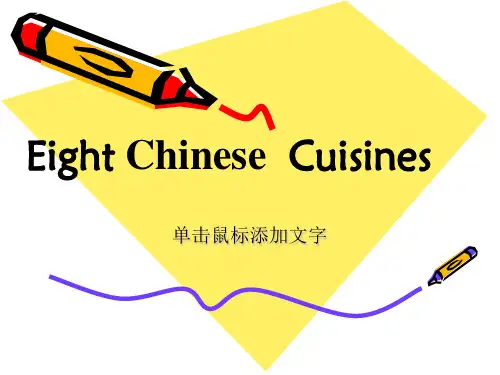
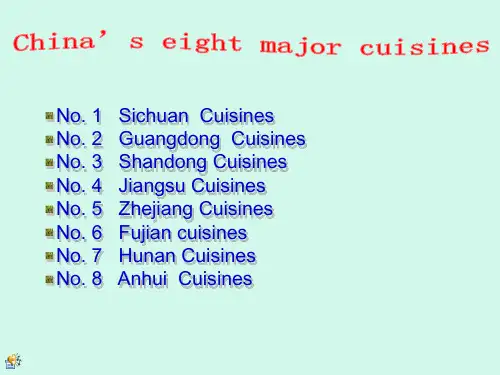
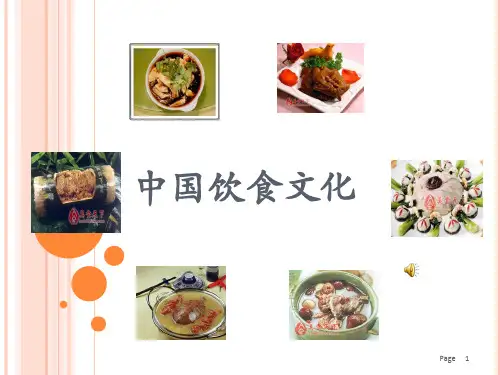
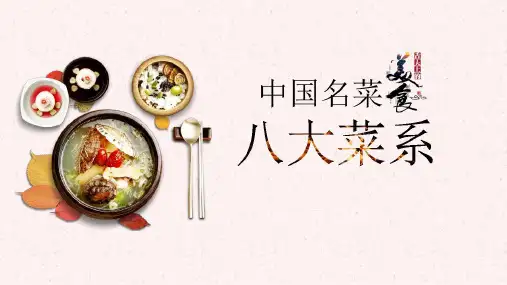
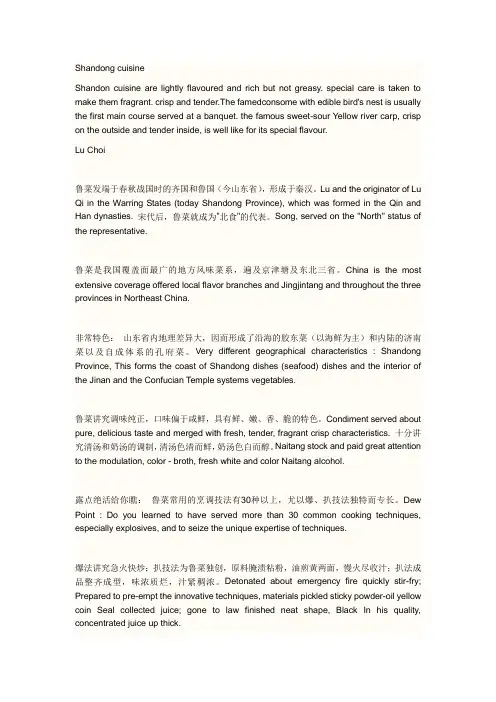
Shandong cuisineShandon cuisine are lightly flavoured and rich but not greasy. special care is taken to make them fragrant. crisp and tender.The famedconsome with edible bird's nest is usually the first main course served at a banquet. the famous sweet-sour Yellow river carp, crisp on the outside and tender inside, is well like for its special flavour.Lu Choi鲁菜发端于春秋战国时的齐国和鲁国(今山东省),形成于秦汉。
Lu and the originator of Lu Qi in the Warring States (today Shandong Province), which was formed in the Qin and Han dynasties. 宋代后,鲁菜就成为"北食"的代表。
Song, served on the "North" status of the representative.鲁菜是我国覆盖面最广的地方风味菜系,遍及京津塘及东北三省。
China is the most extensive coverage offered local flavor branches and Jingjintang and throughout the three provinces in Northeast China.非常特色:山东省内地理差异大,因而形成了沿海的胶东菜(以海鲜为主)和内陆的济南菜以及自成体系的孔府菜。

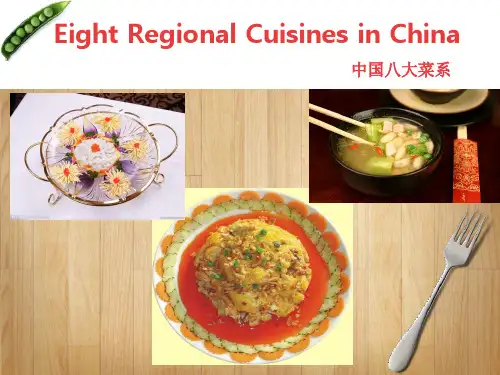
八大菜系的作文英语英文回答:The Eight Culinary Traditions of China.China's culinary landscape is as diverse as its vast terrain, with each region boasting its own unique culinary traditions. These eight distinct cuisines have shaped the nation's gastronomic heritage, showcasing the rich flavors, innovative techniques, and cultural influences that have defined Chinese cuisine over centuries.1. Shandong Cuisine (鲁菜)。
Renowned for its use of seafood, Shandong cuisine emphasizes freshness and simplicity. Steamed fish, stir-fried dishes, and soups showcase the natural flavors of local ingredients.2. Sichuan Cuisine (川菜)。
Bold and fiery, Sichuan cuisine is known for its use of chili peppers, garlic, and other spicy ingredients. Mapo tofu, twice-cooked pork, and kung pao chicken are iconic dishes that exemplify the region's fiery flavor profile.3. Cantonese Cuisine (粤菜)。
八大菜系中英文对照版中国的八大菜系与英文翻译中国自古就是一个拥有丰富饮食文化的国家,不同地区的菜系各具特色,味道各异。
中国的八大菜系被视为中国饮食文化的代表,它们是鲁菜、川菜、粤菜、苏菜、闽菜、浙菜、湘菜和徽菜。
下面将为大家介绍这些中国的八大菜系,并附上相应的英文翻译。
一、鲁菜(Shandong Cuisine)鲁菜,又称山东菜,是中国最著名的菜系之一,以山东地区为代表。
鲁菜讲究色、香、味的协调,注重原料的新鲜和烹调技巧的精湛。
主要特点是烹调方法多样,口味咸鲜,选料注重,制作讲究,炒、爆、炸、煮等技法熟练。
在中式烹饪中占有很重要的地位。
二、川菜(Sichuan Cuisine)川菜,又称川菜,是中国四大菜系之一,以四川地区为代表。
川味重油辣麻,以辣椒、花椒为主要调味料,口感鲜香麻辣,味道浓重,善于烹饪红烧、烧烤、干锅等菜肴。
三、粤菜(Cantonese Cuisine)粤菜,又称广东菜,以广东地区为代表。
粤菜讲究选料新鲜、制作精细,烹调技巧高超,口味清淡,口感鲜嫩,清淡鲜爽,色香味俱佳,被誉为中式烹饪之魁。
四、苏菜(Jiangsu Cuisine)苏菜,又称淮扬菜,以江苏地区为代表。
苏菜品种丰富,风味独特,以刀工精细,火工灵活,原汁原味见长,擅长烹调清蒸、红烧、炒、炸等烹调方法,口感鲜嫩。
五、闽菜(Fujian Cuisine)闽菜以福建地区为代表,是中国特色的一种菜系。
闽菜注重海鲜的烹调,食材新鲜,口味清淡,烹饪方法多样,尤其擅长海鲜的烹调,口感鲜嫩,清香爽口。
六、浙菜(Zhejiang Cuisine)浙菜,又称川菜,以浙江地区为代表。
浙菜清淡鲜香,以海鲜为主,注重鲜、嫩、淡、脆之味,注重保持菜品的本色,烹调技巧精湛,被誉为“中国菜中的山珍海味”。
七、湘菜(Hunan Cuisine)湘菜,又称湖南菜,以湖南地区为代表。
湘菜以酸辣咸鲜为主要口味,以辣椒、蒜、姜等为调味料,色香味俱佳,口感鲜甜。
介绍中国八大菜系的英语作文The Eight Major Cuisines of ChinaChina is renowned for its rich and diverse culinary traditions, and the eight major cuisines stand out as the most representative and distinctive.The Sichuan Cuisine is known for its bold and spicy flavors. Dishes like Mapo Tofu and Kung Pao Chicken are favorites due to the generous use of chili peppers and Sichuan peppercorns. The Cantonese Cuisine emphasizes freshness and natural flavors. Dim Sum, Roast Goose, and various seafood dishes are highly popular.The Shandong Cuisine features a wide range of seafood and emphasizes the quality of ingredients. Braised Sea Cucumber and Sweet and Sour Pork are classic examples.The Jiangsu Cuisine is characterized by its delicate and elegant presentation. Dishes such as Stewed Crab with Clear Soup and Yangzhou Fried Rice are well-known.The Zhejiang Cuisine focuses on light and fresh tastes. West Lake Fish in Vinegar Gravy and Dongpo Pork are some of its signature dishes.The Fujian Cuisine is famous for its use of various broths and seafood. Buddha Jumps Over the Wall is a renowned delicacy.The Hunan Cuisine is similar to Sichuan Cuisine in its spiciness, but with its own unique style. Stinky Tofu and Mao's Braised Pork are typical.These eight major cuisines showcase the vast culinary landscape of China, each with its own unique charm and appeal.翻译:《中国八大菜系》中国以其丰富多样的烹饪传统而闻名,八大菜系是最具代表性和独特性的。